Prototype for the Management of Engineering Companies and the ICT to Improve the Quality of Services
Volume 5, Issue 5, Page No 698-708, 2020
Author’s Name: Segundo Moisés Toapanta Toapanta1,a), Emmanuel Alejandro Narváez Picon1, Luis Enrique Mafla Gallegos2
View Affiliations
1Department of Computer Science, Universidad Politécnica Salesiana (UPS), Guayaquil, 090150, Ecuador
2Faculty of Systems Engineering, Escuela Politécnica Nacional (EPN), Quito, 17-01-2759, Ecuador
a)Author to whom correspondence should be addressed. E-mail: stoapanta@ups.edu.ec
Adv. Sci. Technol. Eng. Syst. J. 5(5), 698-708 (2020); ![]() DOI: 10.25046/aj050586
DOI: 10.25046/aj050586
Keywords: Prototype, Quality of Services, Business management, Information technologies, Engineering and ICT Companies
Export Citations
Information on alternative technologies or new prototypes was analyzed to help improve the quality of business management services. The problem is the lack of application of new technologies that improve the quality of service and reduce disagreements in the management of organizations. The objective is to present a prototype for the management of engineering and ICT companies to improve the quality of services. The deductive method and exploratory research were used to analyze the information. The result was a mixed conceptual model of quality of service approach, a dual-security architecture for business management, control of algorithms with processes for quality of service and control of algorithms with information filter. It was concluded that an information filter with Blockchain is considered a fundamental alternative to provide control, reliability, immutability and improved quality of service.
Received: 10 August 2020, Accepted: 11 September 2020, Published Online: 05 October 2020
1. Introduction
With the rapid development of IT technology the types of decision-making in business management depend on several IT information systems. The systems fail or crash business management risks and negative impacts are continually increasing [1].
Globalization and information technologies help the external commercialization of goods and services. The importance in the management of foreign trade are priority properties such as: Handling of goods, costs and administrative failures [2].
Knowledge Management is a scientific area related to the organizational value of knowledge and is understood as a multidisciplinary research field. The notions and practices that emerged and incorporated into organizations in different areas of IT service management the environment is unstable characterized by uncertainties and changes and technology changes rapidly. Competitors multiply products or services that quickly become obsolete and management is increasingly focused on knowledge of user management. Information systems aligned with existing corporate knowledge management and intellectual capital aims to explicitly represent and manage the different dimensions of organizational knowledge and competencies [3].
The objective of this document is to prototype the management of engineering and ICT companies to improve the quality of services.
Why is it necessary to make a prototype for management of engineering and ICT companies to improve the quality of services?
To manage the products and services of engineering and ICT companies with quality, effectiveness and efficiency.
The related and revised articles used for research are as follows:
A CPS-Based Intelligence-Awareness Platform for IT Service Management [1]. A Hyperledger Technology Approach to Mitigate the Risks of the Database in Foreign Trade Management [2]. A Knowledge Management Architecture for Information Technology Services Delivery [3]. A model to improve quality of service (QoS) in cloud based Virtual lab framework [4]. A Strategy for Server Management to Improve Cloud Service QoS [5]. A Study on R&D Organization Management of Japanese ICT Companies Using Patent Information [6]. Achieving agility and quality in product development – an empirical study of hardware startups [7]. Overview of Additive Manufacturing Informatics: “A Digital Thread” [8]. Adoption of Information and Communications Technology in the Turkish Forest Products Industry: A Case Study [9]. An Adaptive Framework for Improving Quality of Service in Industrial Systems [10]. Analysis Methods for Improving Quality of Service Metrics in Flying Ad Hoc Networks [11]. Analysis to Predict Cybercrime Using Information Technology in a Globalized Environment [12]. A Versatile Software Defined Smart Grid Testbed: Artificial Intelligence Enhanced Real-Time Co-Evaluation of ICT Systems and Power Systems [13]. Basics of Forming an Integrated Management System [14]. Cluster Content Caching: An Energy-Efficient Approach to Improve Quality of Service in Cloud Radio Access Networks [15]. Definition of an ICT Management Model to Mitigate Cyberbullying Risk in Social Networks [16]. Elimination of Losses in Information Services Based on Approaches of IT-Service Management [17]. Enabling Enhanced Data Security for Aquaculture Management Services [18]. Quality-of-Service based Energy Trading Mechanism for Microgrids in a Distribution Network [19]. Quality of Service Evaluation of VoIP over Wireless Networks [20]. Exploring the Different Combinations of Technological Capability and Technology Management Capability in Different Stages of New Product Development [21]. Modeling Equipment Hierarchy and Costs for ICT solutions [22]. An Improved Quality-of-Service Performance Using RED’s Active Queue Management Flow Control in Classifying Networks [23]. Improved Quality of Service in ZigBee Network with Statistical Modeling [24]. Quality of Service Enhancement in Wireless LAN: A Systematic Literature Review [25]. Improving Quality of Experience of Service-Chain Deployment for Multiple Users [26]. Quality Improvement in Web Services Using function Replication [27]. Systems and software engineering — Engineering and management of websites for systems, software and services information [28]. Work in Progress: Management of technological development projects in the engineering undergraduate – A knowledge management approach and interdisciplinary [29]. Novel User-Placement Ushering Mechanism to Improve Quality-of-Service for Femtocell Networks [30]. Prototype of an alignment model of the Ministry of Telecommunications and the Information Society to a public organization in Ecuador [31]. Intelligent Quality of Service Aware Traffic Forwarding for Software-Defined Networking/Open Shortest Path First Hybrid Industrial Internet [32]. Quality of Service Provisions for Maritime Communications Based on Cellular Networks [33]. Role of Information and Communication Technology in Green Supply Chain Implementation and Companies’ Performance [34]. Service Quality Evaluation by Exploring Social Users’ Contextual Information [35]. Strategic Management for IT Services Using the Information Technology Infrastructure Library (ITIL) Framework [36]. The Influence of IT Service Management Performance Measurement To Customer Satisfaction [37]. The Study of e-Government Implementation in Improving the Quality of Public Services [38]. Trust-Based Service Management for Mobile Cloud IoT Systems [39]. Using Bayesian Network to estimate the value of decisions within the context of Value-Based Software Engineering [40].
It uses the deductive method and technique of exploratory research that allows us to work and study the information of the articles presented.
The results are primarily criteria for information security in systems that prioritize data integrity and security through encryption and security protocol. An algorithm with flowchart techniques to mitigate data security and thus achieve quality improvement as an end goal the prototype made can be used as a reference for other ICT engineering and management companies to improve the quality of services.
Turned out a mixed conceptual model of quality-of-service approach, a dual-security architecture for business management, algorithm control with processes for quality of service and information filter algorithm control.
It is concluded that a Blockchain-secure information filter is considered a critical option to provide control, reliability, immutability and improvement in quality of service.
2. Materials and Methods
2.1. Materials
The authors proposed an IT service management platform based on the cyber physical system to improve the process and build a smart industry. They identified companies with resources for software, hardware and troubleshooting programs. They analyzed the lower efficiency and quality of service to provide a good service with a degree of difficulty especially in the physical condition of the business management facilities. Results promote IT service efficiency and provide advance notice in the life cycle management process of IT department resources [1].
In this article the authors proposed a Blockchain system as an architecture and model applied to different areas to increase the level of information security. Determined the little diversity of proposals applied in Hyperledger to the commercialization area. They generated an architecture based on Hyperledger to mitigate the risks of information in the management of foreign trade. A comprehensive management model in exports and imports based on Hyperledger was proposed as a collaboration platform in the company’s areas [2].
In organizations with a field in which researchers develop new innovations and improvements for the provision of service to users and clients. The authors analyzed IT business as unstable due to increased competition in technological development and as a result products became obsolete. Research provides a structure that produces good results so that service delivery can be improved [3].
The authors proposed the use of the cloud for better dynamics in education in universities for the use of e-learning materials. They obtained improvements in response time in accordance with the relevant restrictions so that resources are used appropriately and in a timely manner in the company [4].
The authors proposed an analysis of the cloud as data storage services on the network using a device. Identified a problem in the servers in the cloud when the servers stopped working and caused high power losses. As a result they identified typical solutions to save energy without causing loss of information and resources while the server is idle without affecting the quality of service [5].
The authors carried out a study about the difficult situation that companies go through due to poor management by managers. An investigation was carried out on the core of the company’s staff on the basis of the comparisons made between Japanese and foreign technology development companies focused on ICT. As a result the area of technological development was verified as one of the Japanese ICT societies with greater central rigidity than foreign ones [6].
The authors proposed an implementation of an initialization system for companies that have a great possibility of growth in order to seek growth. Conducted user tests in order to improve the system in accordance with the innovative prototypes installed to improve the quality of service. As a result of the implementation the attention of users was improved to obtain growth and the business was scalable and profitable [7].
In this article the authors analyzed manufacturing processes in companies to improve service in the supply chain through digitization. They captured information throughout the product lifecycle to analyze cost reduction and delivery times to improve efficiency. As a result of the research the information is managed during the program process through complete maintenance with individual processes to create the final part [8].
The authors proposed an analysis of the experimentation of change in business interactions and operations in the ICT department. They conducted an investigation of the factors that affected the use of computers and the Internet in forests. As a result companies improved the ICT service for electronic commerce in which they used to do electronic business more effectively [9].
The authors proposed a flaw detection system to improve the quality of service in real-time multimedia applications. A memory mirroring system was implemented to limit the overhead on the system and the installation of virtual machines to improve the quality of service. As a result methods were applied to access additional memory in real time [10].
The authors proposed an analysis of data transmissions to improve efficiency according to the scenarios applied in the system. Reviewed quality of service metrics on multiple data transactions at different levels. As a result they obtained a level of efficiency in the retransmission of lost data through the application of a network of analytical calculations; this system was adapted to the source nodes in the system [11].
The authors proposed a data tree technique to mitigate cyber-attacks on the network. They applied data mining to identify vulnerabilities in the Blockchain network with the use of trees. As a result a robust system was obtained with detection of threats in the network and provided reliability in the system [12].
The authors proposed a versatile platform that exposes an application-provided Smart Grid benchmark architecture. They incorporated real-world wireless technology with an artificial intelligence algorithm to facilitate real-time tested design requirements. As a result a better evaluation potential was obtained in the systems implemented in the company [13].
The authors proposed a design management system for the use of procedures and policies to provide efficient filing of company processes. They opted for integrated management systems to allow greater efficiency at lower costs to grow competitively. As a result a management system was obtained that works autonomously without affecting the general direction [14].
The authors proposed a network architecture with connection to mobile devices over a network to provide high-speed services. An exchange of data from an origin to destination point was identified that caused high energy consumption and a low quality of service. As a solution a storage management system was implemented for centralized processing in order to improve and obtain performance gains in the system [15].
The authors proposed an ICT management model to moderate the situations of non-compliance to which users are exposed. They used logical research as a methodology to analyze information on the rates of users of social networks in Ecuador. They also established a conceptual model related to the development of digital skills in a qualitative description in the management of digital content by children and adolescents [16].
The authors proposed an information services loss elimination system based on IT service management approaches in an effective way. They implemented a system that benefits several companies in different countries. As a result of the implementation the activities in the IT departments were optimized that allowed reducing the consumption of resources [17].
The authors proposed a method to avoid some kind of private data transfer over the network. They scrambled sets of random numbers to make encryption keys in a client-server system to provide information security [18].
The authors proposed a microgrid system with power generation techniques that work autonomously; with the implementation of microgrids better service is provided to customers to provide reliability compared to a distribution network. As a result the cost of energy supply of the microgrids was analyzed for the verification of implementation costs to improve the system [19].
The authors proposed an analysis of the performance of IP voice in wireless networks to determine the problems that exist in the loss of voice packets. In the analysis communication models were obtained through the Internet according to the bandwidth established by an installed protocol. The set of resources and restrictions that caused a weak signal in a user’s communication was identified [20].
The development and quality of new products determine the current positions that are in the market of companies that use long-range positive impacts in the implementation in future companies. Benchmarking is used to explore technology capacity and management to drive high performance to capture new markets and provide opportunities for product innovations [21].
The authors made a comparison between information systems and modeling approaches to have a limited level of detail and provide a more generic solution for equipment cost modeling. This method ensures that models can be easily communicated shared and reused by generating a great advantage over the use of sheet models and calculations [22].
The authors designed a scheduling algorithm to improve buffering performance. An algorithm was implemented to improve the packet drop that solved the usage savings due to the slowness of the bandwidth. As a result it was self-tuning and network traffic was managed to produce increased stability in storage parameters [23].
The authors proposed a system to optimize performance more efficiently to improve the quality of service in network parameters. They implemented sensor nodes to facilitate the performance in the connections with the devices that affected the overall performance of the network [24].
The authors performed an analysis of users that require a network service in their homes and workplaces as a necessity to perform different activities. Increased numbers of wireless network users and devices were identified at a reasonable cost of implementation at the time to provide good product service [25].
Service optimization has been a latent issue so it affects the product service to solve this problem: An algorithm was created with that it was experimented and as a result it was obtained that reduced the delay time and at the same time reduced rejections [26].
The authors proposed an improvement in the network service to achieve better efficiency and reliability of the system. A coupling was implemented according to the measure used in the most common services to increase independence. Process replication processes were carried out to reduce the rate of errors in the system. They grouped functions by groups to generate new relationships in order to improve large-scale processes [27].
The authors analyzed websites for commercial marketing and social media purposes that reflect different interests and media choices for those websites that offer ICT reference information. The objective of this method is to improve the usability of informational websites and the ease of maintenance of monitored web operations in terms of locating relevant and timely information [28].
The authors proposed a technological development for the creation or improvement of products according to the design and implementation of a program. They improved product quality for Peruvian universities that were forced by the saturation of the workforce in the standardization of processes for higher education [29].
In this document they offer a real-time application for the final product that is critical for mobile applications through wireless channels. With product maintenance in a wireless environment it is very difficult based on limited resources. The proposed method was a two-dimensional map for users to help locate the desired location with the positioning system [30].
The authors proposed a prototype to improve the quality of service in users belonging to the administrative of state department in accordance with technological advances. As a result an alignment model was obtained for the Ministry of Telecommunications for the use of a methodology that allowed to know the management and strategies [31].
The authors conducted an analysis on the use of resources to improve the use of smart manufacturing technology. Compliance requirements were identified to acquire better service quality indices according to remote surveillance parameters or anomaly detection. As a result an emerging software-defined network architecture for network heterogeneity and traffic congestion has been proposed to improve system reliability [32].
The authors proposed a communication architecture centralized in the user for the distribution of antennas. Used a mathematically modified cellular technique oriented network scenario in the open ocean and processes should be used to improve traceability and packet transfers for better communication between two points [33].
Currently companies are looking for a way to make technological updates that do not affect our environment and that in turn give us very good benefits. Today environmental care has become very popular among companies, suppliers and customers by not taking care of the environment they have a negative impact. As a result customers or consumers lean towards other companies that do respect and help take care of our planet. Currently taking care of the environment is no longer an option if not an obligation companies have taken advantage of the use of good strategies to supply consumers [34].
The authors analyzed the impact of the use of social networks as a means of communication for the use of professional and daily life. They identified that the product service is very fundamental for users who prefer to share their experiences of an application or a visited place; the majority of companies publish publications to promote their product and thus the message reaches more people according to the appeal of the publication. We would use entropy to calculate the trust of users. We would review the rating of emotional characteristics and a unification to calculate an overall trust [35].
The authors proposed a system for telecommunications equipment to store, retrieve, transmit and manipulate data to improve the strategies and services of the information technology department. They identified strategic changes in IT planning and services as a complex system; they obtained an improvement in the efficiency of the system to handle the different processes for file management. As a result standards were obtained that provide a better IT service with a methodology focused on the customer and commercial service they guaranteed a quality service [36].
This study aims to see the problems that exist with the customer in the IT service through surveys to evaluate customer satisfaction. Measurement according to customer satisfaction levels is to improve performance through performance evaluations. Performed statistical tests to test correlation analysis and enterprise-level performance appraisal method design [37].
The authors conducted a study on electronic governments as a problem according to UNU surveys. The purpose of this study is to measure public perception of the implementation of e-government in the Bandung region society using the MMR method that combines quantitative methods through surveys and a qualitative method with complex processes. As a result it was achieved that in most dimensions an improvement such as: Availability costs, technology, reputation and support should be implemented while the benefit and content are good. Therefore before they can be implemented efforts should be considered in the quality of public products [38].
The management of hierarchical services allows the client to let us know his experience of quality of service through a report and consultation. An application containing smart city travel services, air pollution detection and response exceeds service management protocols. Most IoT devices are mobile and they connect through the internet depending on where you are and the power status device management trust is necessary as not all devices will be trusted and others may be malicious to the cloud service [39].
With the application of Bayesian networks today decision making in software engineering with a competitive, innovative and growth approach for the company. Therefore they need to make changes in the paradigms of values where a study was carried out taking into account the characteristics which are stored in a database. Where an estimated model was obtained with the use of Bayesian networks which have created a positive result within companies in their software products [40].
2.2. Methods
Considerations
We propose to use a technique to store information securely and permanently with tracking functions such as: Blockchain we also propose to use a quality-of-service prototype combining these two new proposals in the management of companies we will have a prototype to improve the desired quality of service.
Comparative table
In Table 1 we have a better view of the references what presents the technology on that the authors were based and a description of the proposal.
Table 1: Article Comparison
| Ref. | Technology | Method or process | Security/Efficiency |
| [1] | Cyber system environment. | Providing quality service to promote effective information technology service. | Promote early alarm in IT resource lifecycle management, process optimization and IT resource service. |
| [2] | Secure Information Block Architecture. | Provides an architecture for mitigating management. | Moderate information risks through secure information block and Hyperledger-based foreign trade management. |
| [3] | Service technology delivery model. | Develop and innovate technological advancement to increase competitiveness. | Storage of important data that improved security and service to users with increased contribution to IT service delivery. |
| [4] | E-learning model. | Enable user interaction with material in a fast, reliable and cost-effective manner.
|
Cloud data storage such as the use of computing resources properly and thus provide efficiency to improve quality of service. |
| [5] | Management architecture for the server. | Effective three-state strategy for servers. | Reduced power consumption to prevent loss of information handled through the cloud get a quick response from servers and improve quality of service. |
| [6] | Information Platform Architecture. | Adaptive framework that prevents attacks and threats to protected data. | Data rigidity by computer means and social media platforms with foreign companies. Building core capabilities with changes in market competitiveness and data rigidity. |
| [7] | Agility structure and quality of startups. | Data collection through interviews and documentation. | Developing innovative new products help achieve growth by making a business scalable. |
| [8] | Digital application of manufacturing innovation. | In the applications data is stored of the services offered with respective evaluations for the quality of service. | Integrated tools are given parts for reliable playback and ensures smooth response timely process evaluation. |
| [9] | Adaptation of information technology in the industry. | Analysis of the environment of company to make use in business through information technology. | Business productivity, exchange of data or information with customers and facilitations of banking transactions. |
| [10] | Adaptive optimization service model. | Automatic detection device for the final product in real time. | Application to access memory in real time to offer good product quality in real time. |
| [11] | Data relay method. | Analyze the network with data in order to relay lost data applicable on different nodes. | Multiple transmission that was only adaptable on source nodes but also on various source nodes. |
| [12] | Data mining software. | Identify and detect cyberattacks using a data tree. | Data mining was applied when using mining software in the implementation of the decision tree technique for the detection of cyberattacks. |
| [13] | Neural search algorithm. | A test bench is displayed in that wireless technology is incorporated. | Software that incorporates wireless technology that has an AI algorithm to show a potential for Smart Grid test assessments. |
| [14] | Integrated system stage modeling.
|
Integrated system for quality management and training of the management system. | Management systems are opted as it helps to grow competitively and thus offers greater efficiency. |
| [15] | Accuracy method of performance results. | Use maximum cache storage and signal processing. | Improved performance gain and centralized processing was demonstrated through caching. |
| [16] | Conflict management model. | Analyze management information to solve problems. | Moderation of non-conformance situations that users are exposed to. |
| [17] | Structure of production processes and tools. | Optimize operating costs and achieve the objectives of information technology services provided. | The use of Lean helps to optimize activities and allows a considerable reduction in resource consumption. |
Table 1 provides a brief description of the most relevant articles that were taken as a reference for the analysis of new technologies; in this way the processes are visualized in short detail together with their method and in turn the safety and effectiveness to complement the decision-making based on the proposed results.
3. Results
The results we have proposed for this phase based on studies to improve the quality of service, security and technologies that were implemented are:
- Mixed Conceptual Model of Quality of Service Approach.
- Dual-security architecture for business management.
- Control of algorithms with processes for the quality of services.
- Control of algorithms with information filter.
3.1. Mixed Conceptual Model of Quality of Service Approach
The presented model of new prototypes for the management of engineering and ICT companies to improve the quality of services is represented in Figure 1.

Figure 1: Conceptual model
Figure 1 shows the conceptual model segmentation in prototypes that have been referenced in three sectors called data security, quality of services and methodologies. There are different application scenarios, keys and techniques in that analyses and designs are applied with knowledge platforms and an algorithmic to optimize customer-oriented activities and improve service according to the management of company engineering.
The mathematical basis for measuring the conceptual model presented is expressed in the following formula (1):
![]()
here:
ADMC is the amount of reliance on managed companies.
ADB is the number of direct beneficiaries.
ACO is the number of control offices.
AIOC is the number of reports per control office.
AIB is the number of indirect beneficiaries.
Formula (1) is applied to measure the conceptual model: Six scenarios were identified in the implementation according to business management; in the first scenario agricultural engineering was established with a measure of 97.62%; for systems engineering you have a measure of 82.99%; industrial engineering has a measure of 98.77%; electrical engineering has a measurement of 94.34%; in mechanical engineering a measure of 84.03% was obtained and in electronic engineering a measure of 90.03% is available.
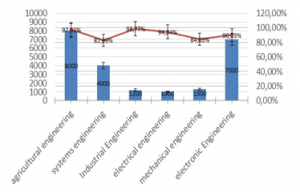
Figure 2: Measuring the conceptual model
Figure 2 shows the percentages of measurement of the management of engineering companies taking into account certain value indicators. Results allow you to have a view of the percentage-level comparisons of each engineering segmentation by approach to each management.
3.2. Dual-security architecture for business management
We proposed an architecture for business management in this case in the field of engineering. The participation of actors such as: Parent company, entity, branches and suppliers is established. Participants have an individual role according to process management, configuration management, control and supervision in the exchange process.
Figure 3 shows the architectural proposal for business management consists of the following parts: Information platform, application, matrix, distribution, protocol filter and evaluation with information risk calculation.
The Blockchain architecture we propose is established according to immutable information, audited information and encrypted data. Consensus among participants that update the information. Participants have an authentication certificate.
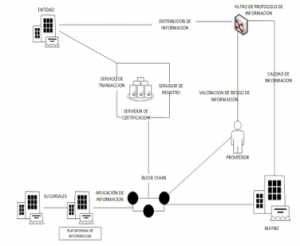
Figure 3: Dual-security architecture for business management
All actors will have a copy of the information in the Blockchain and localities are authorized to enter information related to the management of their area. In the operation of the management model branches have a general identifier for querying data.
We propose that the Blockchain be on the platform in order to intervene between the matrix and the corresponding entities; the model establishes authentication to determine network entry and update information if necessary; these actors aim to give their consent to update the data to form the consensus.
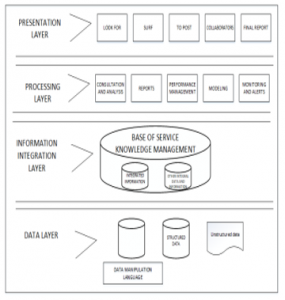
Figure 4: Four-layer architecture model
Figure 4 shows a layered architecture consisting of four levels to perform a successful process with data exchange with the company address.
Presentation layer is assigned the search, navigation, publication, collaboration and preparation of a final report.
Processing layer query and analysis processes, report management, performance management, modeling, monitoring and alerts are established.
Information integration layer is the foundation of service knowledge management, integrated information and other data with integrated information.
Data layer are databases for data manipulation, structured data and unstructured data all data is stored here.
3.3. Control of algorithms with quality of service processes
We proposed an algorithm as a guide in the process of new prototypes for the management of engineering and ICT companies to improve the quality of services; the algorithm aims to improve the steps of the methodology to avoid risks in information.
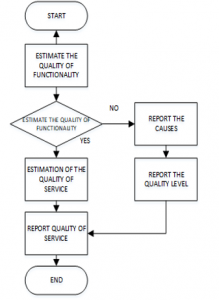
Figure 5: Information control algorithm
Figure 5 shows the application steps of the Quality of Service algorithm as a start to estimating the quality of functionality. The algorithm values the process of managing the operation of parameters. The system validates the quality of service condition and estimates under an internal range to report the quality of the service. If the system does not meet the requirements the causes are reported and the level is validated to the appropriate quality standards; after the transaction is successful the system generates a report on the quality of the final product.
The mathematical basis for measuring the improvement in the quality of service as a final product is expressed in the formula (2):

here:
CS is the quality of services.
AS is the number of surveys.
AM is the amount of tracking.
AA is the number of alerts.
AC is the number of collaborators.
LF is the level of functionality.
For the measurement of the algorithm an example was made and the formula (2). Was applied the following example shows the use of the formula. For the improvement of the data a 31% was obtained; for the improvement of satisfaction you have a measurement of 25%. For the improvement of efficiency was obtained 17% and for the measurement of the productivity improvement 29% was obtained.
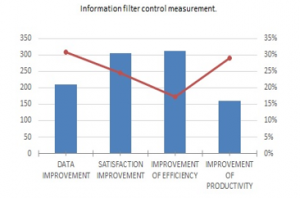
Figure 6: Information filter control
Figure 6 shows the measurement percentages of the improvement in quality of service in order to propose a prototype focused on different areas of engineering. You get an increase in data improvement by 31% over existing quality within the company and also improves satisfaction, efficiency and productivity. This was achieved through data collection through surveys, partner tracking and the level of functionality.
3.4. Control of algorithms with quality of service processes
We proposed an algorithm for engineering and ICT company management processes to improve the quality of services. The algorithm aims to improve the steps of the methodology to avoid risks in the control of information.
A process is maintained in that filters based on information and communication technologies are adopted to have greater control of the database. In the execution of this network of filters could be estimated an improvement in the process and obtain an increase in the quality of service. Information is partitioned into four stages such as blocking, processing, storing and exchanging it.
It should be noted that the algorithm process we have in mind can be applied to several management engineering companies in order to obtain an increase in favor of the data collected before obtaining it. This refers to that after applying the established algorithm could be reference to great power of quality information since in this way the results obtained can be measured more reliably.
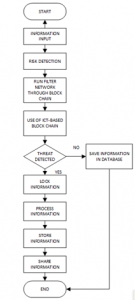
Figure 7: Control algorithm for information
Figure 7 shows the implementation steps of the control algorithm for information. First we have the input of information here is the input of all the parameter information. Risk detection finds the process of detecting anomalies in the data. In the process of a filtering network runs through Blockchain and its ICT-based use to analyze threats. A threat detection process is executed if the system detects the information is blocked then the information is processed according to the parameters the information is stored and shared. If the condition is met the information if the system does not detect a threat on the network is saved in a database engine and the process ends.
The mathematical basis for measuring control for the information presented is expressed in the formula (3):

Here:
AUP is the amount of ICT-based Blockchain usage process.
AIE is the amount of information entered.
ARD is the amount of risk detected.
AFN is the amount of filter on the network.
Formula (3) was used for the measurement of the information control algorithm; for blocked information a measure of 71% was established; for the information processed the measure was 7%; for stored information a measure of 33% was established and for shared information a measure of 13%.
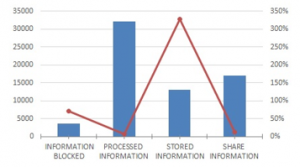
Figure 8: Filter control measurement information
Figure 8 shows the measurement percentages of the information filter control taking into account certain value indicators. This allows you to have a glimpse of the filtration process via Blockchain.
4. Discussion
To propose the results of this research we adopt Blockchain technology [2] to give a higher level of security consistency to the information that is generated and to avoid malicious actions in the handling of information. We also adopt architecture and reference information [3]. We even take quality management models [14] and along with modeling the quality of services [19]. Collecting future relevant data through the established prototype.
The results obtained were mainly criteria for the security of company management in systems that prioritize data security. Quality of services through encryption and protocol.
In the research process an algorithm scheme was determined they used flowchart techniques as an option for information control in business management; the manufactured prototype can be used as a reference for other quality of service management companies. A second algorithm scheme was obtained using flowchart techniques as a process option to obtain the quality of services as a final product.
5. Future Work and Conclusions
In the future we proposed that the integration of the Engineering Companies and the ICTs be carried out to improve the quality of the services of internal and external users. The results obtained in this investigation are considered as an alternative.
It was concluded that Blockchain is determined as a fundamental option to provide greater control, as well as robustness in the face of malicious failures and attacks. The reliability of the information serves to get a better detail of the report along with the availability that handles a data rate and thus its immutability and security would obtain an improved final product.
It was concluded that Blockchain is determined a fundamental option to provide greater control, robustness in the face of failures and malicious attacks. The reliability of the information serves to get a better detail of the report along with the availability that handles a data rate and thus its immutability and security would obtain an improved final product.
With the obtained indicators applied to the processes downtime was avoided. In this way the integrity and accessibility of information in the management of the security processes of technology companies have a higher priority and option of protection against the improvement of services.
It should be noted that the protocols followed in our experiment are fully applicable in other investigations. These applications need to delve into the issue of new prototypes for the management of engineering and ICT companies to improve the quality of services.
Conflict of Interest
The authors declare no conflict of interest.
Acknowledgment
The authors thank to Universidad Politécnica Salesiana del Ecuador to the research group of the Guayaquil Headquarters “Computing, Security and Information Technology for a Globalized World” (CSITGW) created according to resolution 142-06-2017-07-19 and Secretaría de Educación Superior, Ciencia, Tecnología e Innovación (Senescyt).
- Y. Zhao, Y. Rao, “A CPS-based intelligence-awareness platform for IT service management,” Proceedings – 2017 Chinese Automation Congress, CAC 2017, 2017-Janua, 6668–6673, 2017, doi:10.1109/CAC.2017.8243978.
- S.M. Toapanta Toapanta, L.E. Mafla Gallegos, M.G. Guaman Villalta, N.S. Mora Saltos, “A hyperledger technology approach to mitigate the risks of the database in foreign trade management,” Proceedings – 3rd International Conference on Information and Computer Technologies, ICICT 2020, (March), 313–319, 2020, doi:10.1109/ICICT50521.2020.00055.
- T. Almeida, J.B. De Vasconcelos, G. Pestana, “A knowledge management architecture for information technology services delivery,” Iberian Conference on Information Systems and Technologies, CISTI, 2018-June, 1–4, 2018, doi:10.23919/CISTI.2018.8399202.
- P. Tamang, A. Alsadoon, C. Withana, L.S. Hoe, A. Elchouemi, “A model to improve Quality of Service (QoS) in cloud based Virtual lab framework,” 2015 International Conference and Workshop on Computing and Communication, IEMCON 2015, 1–5, 2015, doi:10.1109/IEMCON.2015.7344519.
- B.M. Nguyen, D. Tran, Q. Nguyen, “A strategy for server management to improve cloud service QoS,” Proceedings – 2015 IEEE/ACM 19th International Symposium on Distributed Simulation and Real Time Applications, DS-RT 2015, 120–127, 2016, doi:10.1109/DS-RT.2015.14.
- I. Nakaoka, H. Fujino, Y. Park, Y. Chen, H. Akaoka, S. Masuyama, “A study on R&D organization management of Japanese ICT companies using patent information,” Proceedings – 2017 International Conference on Advanced Informatics: Concepts, Theory and Applications, ICAICTA 2017, 2017, doi:10.1109/ICAICTA.2017.8090976.
- V. Berg, J. Birkeland, A. Nguyen-Duc, I.O. Pappas, L. Jaccheri, “Achieving agility and quality in product development – an empirical study of hardware startups,” Journal of Systems and Software, 167, 2020, doi:10.1016/j.jss.2020.110599.
- D. Mies, W. Marsden, S. Warde, “Overview of Additive Manufacturing Informatics: ‘A Digital Thread,’” Integrating Materials and Manufacturing Innovation, 5(1), 114–142, 2016, doi:10.1186/s40192-016-0050-7.
- T. GEDİK, İ. DURUSOY, “Adoption of Information and Communications Technology in the Turkish Forest Products Industry: A Case Study,” Kastamonu Üniversitesi Orman Fakültesi Dergisi, 20(1), 38–48, 2020, doi:10.17475/kastorman.705835.
- G. Jia, G. Han, D. Zhang, L. Liu, L. Shu, “An Adaptive Framework for Improving Quality of Service in Industrial Systems,” IEEE Access, 3, 2129–2139, 2015, doi:10.1109/ACCESS.2015.2496959.
- I.A. Kaisina, A. V. Abilov, A. V. Chunaev, M. Aiman Al Akkad, V. V. Khvorenkov, “Analysis Methods for Improving Quality of Service Metrics in Flying Ad Hoc Networks,” Moscow Workshop on Electronic and Networking Technologies, MWENT 2020 – Proceedings, 2020, doi:10.1109/MWENT47943.2020.9067430.
- S.M. Toapanta Toapanta, L.E. Mafla Gallegos, B.E. Cisnero Andrade, M.G. Tandazo Espinoza, “Analysis to predict cybercrime using information technology in a globalized environment,” Proceedings – 3rd International Conference on Information and Computer Technologies, ICICT 2020, (March), 417–423, 2020, doi:10.1109/ICICT50521.2020.00073.
- M. You, X. Zhang, G. Zheng, J. Jiang, H. Sun, “A Versatile Software Defined Smart Grid Testbed: Artificial Intelligence Enhanced Real-Time Co-Evaluation of ICT Systems and Power Systems,” IEEE Access, 8, 88651–88663, 2020, doi:10.1109/ACCESS.2020.2992906.
- Y. V. Velmakina, S. V. Aleksandrova, V.A. Vasiliev, “Basics of Forming an Integrated Management System,” Proceedings of the 2018 International Conference “‘Quality Management, Transport and Information Security, Information Technologies’”, IT and QM and IS 2018, 77–78, 2018, doi:10.1109/ITMQIS.2018.8524955.
- Z. Zhao, M. Peng, Z. Ding, W. Wang, H.V. Poor, “Cluster content caching: An energy-efficient approach to improve quality of service in cloud radio access networks,” IEEE Journal on Selected Areas in Communications, 34(5), 1207–1221, 2016, doi:10.1109/JSAC.2016.2545384.
- R. Maciel, E. Mafla, “Definition of an ICT Management Model to Mitigate Cyberbullying Risk in Social Networks,” (July), 2020.
- O. V. Efimova, N.P. Tereshina, N. V. Tereshina, V. V. Zhakov, “Elimination of Losses in Information Services Based on Approaches of IT-Service Management,” Proceedings of the 2019 IEEE International Conference Quality Management, Transport and Information Security, Information Technologies IT and QM and IS 2019, 128–131, 2019, doi:10.1109/ITQMIS.2019.8928331.
- D. Piplani, D.K. Singh, R. Sharma, M. Aleembaig, “Enabling enhanced data security for aquaculture management services,” Proceedings of the 2017 3rd Conference on Mobile and Secure Services, MOBISECSERV 2017, 2017, doi:10.1109/MOBISECSERV.2017.7886563.
- W. Zhang, T. Meng, Y. Luo, “Quality-of-Service based Enegy Trading Mechanism for Microgrids in a Distribution Network,” IEEE Power and Energy Society General Meeting, 2018-Augus, 7–11, 2018, doi:10.1109/PESGM.2018.8586265.
- K. Alalawi, H. Al-Aqrabi, “Quality of service evaluation of VoIP over wireless networks,” 2015 IEEE 8th GCC Conference and Exhibition, GCCCE 2015, 1–4, 2015, doi:10.1109/IEEEGCC.2015.7060070.
- Y. Liu, W. Wu, P. Gao, K. Liu, “Exploring the Different Combinations of Technological Capability and Technology Management Capability in Different Stages of New Product Development,” IEEE Access, 7, 181012–181021, 2019, doi:10.1109/ACCESS.2019.2959207.
- J. Spruytte, M. Van der Wee, S. Verbrugge, D. Colle, “Modeling equipment hierarchy and costs for ICT solutions,” Transactions on Emerging Telecommunications Technologies, 30(3), 2019, doi:10.1002/ett.3583.
- A.M. Alkharasani, M. Othman, A. Abdullah, K.Y. Lun, “Improved Quality-of-Service Performance Using RED’s Active Queue Management Flow Control in Classifying Networks,” IEEE Access, 5, 24467–24478, 2017, doi:10.1109/ACCESS.2017.2767071.
- N. Islam, M.J.H. Biddut, A.I. Swapna, S. Asaduzzaman, “Improved Quality of Service in ZigBee network with statistical modeling,” Proceedings of 2015 3rd International Conference on Advances in Electrical Engineering, ICAEE 2015, 174–177, 2016, doi:10.1109/ICAEE.2015.7506824.
- M.H. Sanan, K.A. Alam, M.Z. Rafique, B. Khan, “Quality of Service Enhancement in Wireless LAN: A Systematic Literature Review,” MACS 2019 – 13th International Conference on Mathematics, Actuarial Science, Computer Science and Statistics, Proceedings, 2019, doi:10.1109/MACS48846.2019.9024827.
- I.C. Wang, C.H.P. Wen, H.J. Chao, “Improving Quality of Experience of Service-Chain Deployment for Multiple Users,” 2018 IEEE/ACM 26th International Symposium on Quality of Service, IWQoS 2018, 1, 2019, doi:10.1109/IWQoS.2018.8624167.
- M.J. Amiri, M. Koupaee, “Quality improvement in web services using function replication,” 2016 2nd International Conference on Web Research, ICWR 2016, 72–77, 2016, doi:10.1109/ICWR.2016.7498449.
- F.O.R. Standardization, D.E. Normalisation, “Systems and software engineering — Engineering and management of websites for systems, software, and services information,” 1987, 1987.
- J.E.Q. Rojas, J.E.Q. Tuesta, “Management of technological development projects in the engineering undergraduate-A knowledge management approach and interdisciplinarity,” EDUNINE 2019 – 3rd IEEE World Engineering Education Conference: Modern Educational Paradigms for Computer and Engineering Career, Proceedings, (28740), 2–5, 2019, doi:10.1109/EDUNINE.2019.8875798.
- C. Wang, S.H. Fang, H.C. Wu, S.M. Chiou, W.H. Kuo, P.C. Lin, “Novel User-Placement Ushering Mechanism to Improve Quality-of-Service for Femtocell Networks,” IEEE Systems Journal, 12(2), 1993–2004, 2018, doi:10.1109/JSYST.2016.2635158.
- S.M.T. Toapanta, M.J.M. Canales, J.G.O. Rojas, L.E.M. Gallegos, “Prototype of an Alignment Model of the Ministry of Telecommunications and the Information Society to a Public Organization in Ecuador,” Proceedings of the 2020 the 4th International Conference on Information System and Data Mining, (May), 58–64, 2020, doi:10.1145/3404663.3404676.
- Y. Bi, G. Han, C. Lin, Y. Peng, H. Pu, Y. Jia, “Intelligent Quality of Service Aware Traffic Forwarding for Software-Defined Networking/Open Shortest Path First Hybrid Industrial Internet,” IEEE Transactions on Industrial Informatics, 16(2), 1395–1405, 2020, doi:10.1109/TII.2019.2946045.
- Y. Xu, “Quality of Service Provisions for Maritime Communications Based on Cellular Networks,” IEEE Access, 5, 23881–23890, 2017, doi:10.1109/ACCESS.2017.2763639.
- J.R. Mendoza-Fong, J.L. García-Alcaraz, E.J. Macías, N.L. Ibarra Hernández, J.R. Díaz-Reza, J.B. Fernández, “Role of information and communication technology in green supply chain implementation and companies’ performance,” Sustainability (Switzerland), 10(6), 2018, doi:10.3390/su10061793.
- G. Zhao, X. Qian, X. Lei, T. Mei, “Service Quality Evaluation by Exploring Social Users’ Contextual Information,” IEEE Transactions on Knowledge and Data Engineering, 28(12), 3382–3394, 2016, doi:10.1109/TKDE.2016.2607172.
- H. Gunawan, “Strategic Management for IT Services Using the Information Technology Infrastructure Library (ITIL) Framework,” Proceedings of 2019 International Conference on Information Management and Technology, ICIMTech 2019, (August), 362–366, 2019, doi:10.1109/ICIMTech.2019.8843711.
- A.N. Fajar, D.R. Andini, “The Influence of IT Service Management Performance Measurement to Customer Satisfaction,” Proceedings of 2018 International Conference on Information Management and Technology, ICIMTech 2018, (September), 109–113, 2018, doi:10.1109/ICIMTech.2018.8528195.
- Ariwiati, S.F. Ristekawati, R. Febriliantina, Zakiah, “The study of e-Government implementation in improving the quality of public services (A study on society in Bandung region),” 2016 International Conference on ICT for Smart Society, ICISS 2016, (July), 105–110, 2016, doi:10.1109/ICTSS.2016.7792858.
- I.R. Chen, J. Guo, D.C. Wang, J.J.P. Tsai, H. Al-Hamadi, I. You, “Trust-Based Service Management for Mobile Cloud IoT Systems,” IEEE Transactions on Network and Service Management, 16(1), 246–263, 2019, doi:10.1109/TNSM.2018.2886379.
- E. Mendes, M. Perkusich, V. Freitas, J. Nunes, “Using Bayesian Network to estimate the value of decisions within the context of Value-Based Software Engineering,” ACM International Conference Proceeding Series, Part F1377(June), 2018, doi:10.1145/3210459.3210468.
Citations by Dimensions
Citations by PlumX
Google Scholar
Scopus
Crossref Citations
No. of Downloads Per Month
No. of Downloads Per Country
